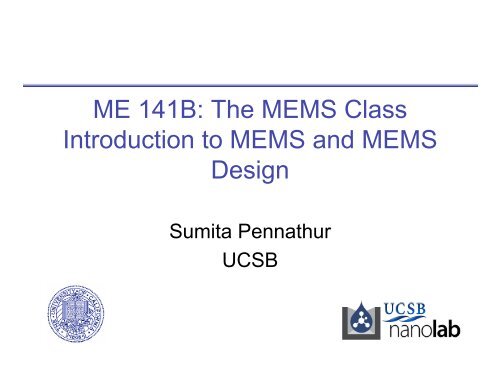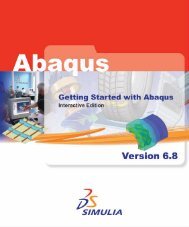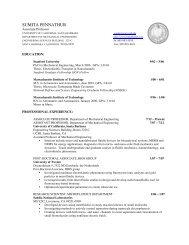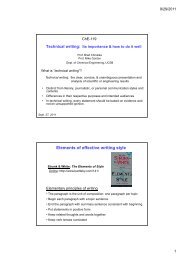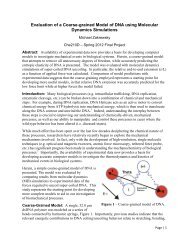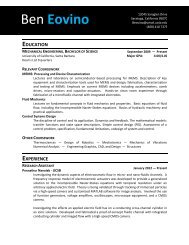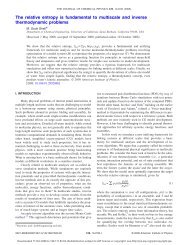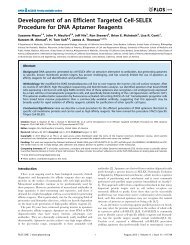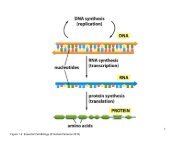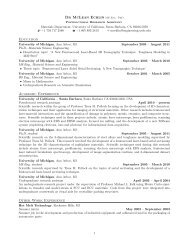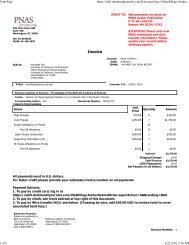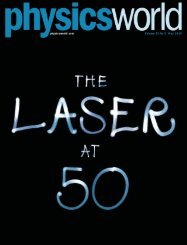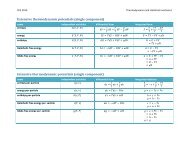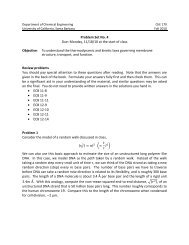ME 141B: The MEMS Class Introduction to MEMS and MEMS Design
ME 141B: The MEMS Class Introduction to MEMS and MEMS Design
ME 141B: The MEMS Class Introduction to MEMS and MEMS Design
Create successful ePaper yourself
Turn your PDF publications into a flip-book with our unique Google optimized e-Paper software.
<strong>ME</strong> <strong>141B</strong>: <strong>The</strong> <strong>ME</strong>MS <strong>Class</strong><strong>Introduction</strong> <strong>to</strong> <strong>ME</strong>MS <strong>and</strong> <strong>ME</strong>MS<strong>Design</strong>Sumita PennathurUCSB
Outline• <strong>Class</strong> odds <strong>and</strong> ends• Intro <strong>to</strong> <strong>ME</strong>MS• <strong>The</strong> Challenge of <strong>ME</strong>MS <strong>Design</strong>• Course Outline• Microfabrication Overview
H<strong>and</strong>outs• Syllabus/Schedule H<strong>and</strong>out Lecturer: Prof. Sumita Pennathur Text: Cambell Fabrication Mehods Grading policy• L-Edit Basics First Assignment, due 10/7 E-mail .tbd file, turn in print-out9/21/10 3/45
• Lecture NotesH<strong>and</strong>outs H<strong>and</strong>ed out at the beginning of class Will be posted online• Safety Training <strong>Class</strong> 10/5 10 people first half of class 10 people second half of class MANDATORY attendance9/21/10 4/45
Course Overview• First week – Overview• Weeks 2 – 7 : Processing <strong>and</strong> Modeling• Weeks 8 – 10: Case Studies• Labs: First 5 weeks – training Next 5 weeks – you are on your own9/21/10 5/45
Course conduct <strong>and</strong> ethics• We encourage teamwork for lab reports,homeworks L-edit, mask design, HW#1 <strong>and</strong> lab reportsmust be written up individually• Cooperation is essential in final lab report• No cooperation is allowed on the takehomemidterm• Any breaches will be dealt severely, withno warnings9/21/10 6/45
Outline• <strong>Class</strong> odds <strong>and</strong> ends• Intro <strong>to</strong> <strong>ME</strong>MS• <strong>The</strong> Challenge of <strong>ME</strong>MS <strong>Design</strong>• Course Outline• Microfabrication Overview9/21/10 7/45
What are <strong>ME</strong>MS?• Micro-Electro-Mechanical Systems• Microsystems• Microfabrication• Microtechnology• Nanotechnology• Etc…9/21/10 8/45
What are <strong>ME</strong>MS?• Microfabrication is a manufacturing technology A way <strong>to</strong> make stuff Adapted from semiconduc<strong>to</strong>r industry• With changes <strong>The</strong>refore, MANY st<strong>and</strong>ard design principles hold• But, has unique elements New Materials : SU-8, PDMS New ways <strong>to</strong> shape them: DRIE New material propertes• Bulk vs. thin film Different physics Regimes• Si at small scales9/21/10 9/45
• Definitions varyWhat are <strong>ME</strong>MS? Usually made via semiconduc<strong>to</strong>r batchfabrications Usually small• Some important dimension is
What are <strong>ME</strong>MS?• Now, many “<strong>ME</strong>MS”have no “E” or “M” Static microfluidicstructures But often are multidomain Electro- other domainis very popular• E.g., electro-thermalfluidic-actuation• Microbubble pumps9/21/10 11/45
<strong>ME</strong>MS: His<strong>to</strong>ry• Some starting points: 1961 first silicon pressuresensor (Kulite)• Diffused Si piezoresis<strong>to</strong>rsmounted on<strong>to</strong> package <strong>to</strong> formdiaphragm Mid 60’s: WestinghouseResonant Gate Transis<strong>to</strong>r Mid 70’s Stanford GasChroma<strong>to</strong>graph (1975)• Way ahead of its time9/21/10 12/45
<strong>ME</strong>MS : His<strong>to</strong>ry• <strong>ME</strong>MS blossomed in the 80s• 1982 Kurt Petersen “Silicon as amechanical matieral”• Mid 80’s BSAC folks (Howe, Muller, etc..)polysilicon surface micromachining9/21/10 14/45
<strong>ME</strong>MS: His<strong>to</strong>ry• Electrostatic Micromo<strong>to</strong>rs Introduced in 1988-1990 MIT <strong>and</strong> Berkeley• Microchip capillaryelectrophoresis <strong>and</strong> labon-a-chip Introduced ~1990-1994 A. Manz, J. Harrison, etc..9/21/10 15/45
<strong>ME</strong>MS: Current Topics• Optical <strong>ME</strong>MS Switching of optical signals Big boom in the late 90’s Big bust in the early 00’sLucent micromirror9/21/10 16/45
<strong>ME</strong>MS: RF <strong>ME</strong>MS• Smaller, cheaper, better way <strong>to</strong>manipulate RF signals• Reliability is issue, but getting there9/21/10 17/45Tunable induc<strong>to</strong>rRF Switch
<strong>ME</strong>MS: Bio<strong>ME</strong>MS• Shows promise for diagnostics• Next Era of Quantitative Biology• No commercial winners yet9/21/10 18/45
<strong>ME</strong>MS: Commercial• This isn’t just academic curiousity• <strong>The</strong>re are products you can actually BUY Pressure sensors in your car & in your body Accelerometers EVERYWHERE Gyroscopes Ink-jet print heads Texas Instruments’ micro-mirror array9/21/10 19/45
<strong>ME</strong>MS: Commercial• <strong>The</strong> major successes have beenpressure <strong>and</strong> inertial sensors• Most mature: 40+ ears• Huge initial market: au<strong>to</strong>motive• Recent access <strong>to</strong> huger commercial market• Easy access <strong>to</strong> physcial signal• Smaller than alternatives• Cheaper than alternatives In medical Market, that means disposable• Can be integrated with electronics• Moderately precise & accurate9/21/10 20/45
Outline• <strong>Class</strong> odds <strong>and</strong> ends• Intro <strong>to</strong> <strong>ME</strong>MS• <strong>The</strong> challenge of <strong>ME</strong>MS <strong>Design</strong>• Course Outline• Microfabrication Overview9/21/10 21/45
<strong>ME</strong>MS <strong>Design</strong>• For our purposes, design means Create a device or system With quantitative performance parameters(e.g., sensitivity) Subject <strong>to</strong> constraints• Size, price, materials, physics• Some clearly defined…some not This is hard no matter what the device is9/21/10 22/45
<strong>ME</strong>MS <strong>Design</strong>• <strong>ME</strong>MS design is hard because <strong>The</strong> manufacturing technology is actually quite imprecise• 10% <strong>to</strong>lerance on in-plane dimensions is typical• Out-of-plane <strong>to</strong>lerances may be much better….or much worse• Fabrication success is NOT a given AND is tied <strong>to</strong> the design• <strong>The</strong> material properties are unknown or poorly known• <strong>The</strong> physics are often “different” Not the traditional size scales• <strong>The</strong> system must be partitioned Which parts can you integrate on-chip?• Packaging is non-trivial NOT like ICsAll these questions should be answered EARLY ON9/21/10 23/45
Some solutions <strong>to</strong> this challenge• Approach #1 Make something easy or not useful, etc..• Approach #2 Do incorrect back-of-the-envelope design <strong>and</strong> then proceed• Approach #3 (grad student favorite) Create a large range of structures One of them will work, hopefully• Approach #4 (the <strong>ME</strong>MS class way) Predictive design of all you know <strong>to</strong> enable chance of first round success Determine necessary modeling strategies for a given problem Be aware of what you don’t know, can’t control, <strong>and</strong> what yourassumptions are9/21/10 24/45
<strong>ME</strong>MS <strong>Design</strong>• Different levels of design Analytical design• Abstracted physics• ODEs, Scaling, Lumped-element models Numerical <strong>Design</strong>• Intermediate approach between physical <strong>and</strong> analyticaldesign Physical level:• 3D simulation of fundamental physics• PDEs, finite-element modeling, etc…• Tradeoff between accuracy <strong>and</strong> effort/time• Always limited by fundamental knowledge of properties or9/21/10specifications25/45
Outline• <strong>Class</strong> odds <strong>and</strong> ends• Intro <strong>to</strong> <strong>ME</strong>MS• <strong>The</strong> Challenge of <strong>ME</strong>MS <strong>Design</strong>• Course Outline• Microfabrication Overview
Course Goal• Course goal: Learn how <strong>to</strong> design/fabricateany microfabricated device/system• Learn how <strong>to</strong> Underst<strong>and</strong> the design process Partition the system Determine <strong>and</strong> model relevant physics Evaluate different designs & fabricationtechniques Underst<strong>and</strong> the linkage between fabrication <strong>and</strong>design9/21/10 27/45
Course Outline• First up: fabrication proceses Lithography Etching CVD Evaporation, Sputtering Moxidation• <strong>ME</strong>MS <strong>Design</strong>• <strong>ME</strong>MS case studies9/21/10 28/45
Course outline• <strong>ME</strong>MS fabrication is intimately coupledwith design Not true of many other worlds Example: diaphragm pressure sensor• Would like <strong>to</strong> use Si because of piezoresis<strong>to</strong>rs• Material choice sets fabrication technology: KOH• Fabrication technology determines shapes <strong>and</strong>physical limits: diaphragm thickness• This in turn affects performanceDeflection ~ (thickness)^-39/21/10 29/45
Outline• <strong>Class</strong> odds <strong>and</strong> ends• Intro <strong>to</strong> <strong>ME</strong>MS• <strong>The</strong> Challenge of <strong>ME</strong>MS <strong>Design</strong>• Course Outline• Microfabrication Overview
Microfabrication Outline• Substrates• Lithography <strong>and</strong> patterning• Doping• Thin Films9/21/10 31/45
• Silicon is adiamondstructurecubiccrystal• Comes withdifferentamount ofeither n-type orp-type dopingSubstrates: Silicon9/21/10 32/45
Silicon: Notation• A direction in crystal coordinates indenoted by square brackets, e.g. [100]• <strong>The</strong> set of symmetrically equivalentdirections is written with braces, e.g.• <strong>The</strong> plane perpendicular <strong>to</strong> a direction isdenoted with parentheses, e.g. (100)• <strong>The</strong> set of symmetrically equivalent planesis written with curly brackets, e.g. {100}9/21/10 33/45
Silicon: Diamond Structure• <strong>The</strong> diamond structure is two facecenteredcubic lattices shifted by ¼ of thebody diagonal. <strong>The</strong>re are four silicona<strong>to</strong>ms per cubic unit cell.9/21/10 34/45
Wafer Orientation9/21/10 35/45
SOI• Silicon wafers with embedded layers, suchas silicon-on-insula<strong>to</strong>r (SOI) wafers• Initial purpose: build IC’s on device layer,<strong>and</strong> buried oxide minimized straycapacitance <strong>to</strong> substrate• Common <strong>ME</strong>MS purpose: bulkmicromachining <strong>to</strong>p layer in<strong>to</strong> moveablestructures with well-controlled thickness9/21/10 36/45
Other substrates• Glass (cheap, high impurity content) Inexpensive base for soft lithography Transparent for optical access Can be very strongly attached <strong>to</strong> silicon wafers via anodic bonding• Quartz/Fused silica• Compound semiconduc<strong>to</strong>rs Optical applications• Plastics• PDMS• Titanium• Sapphire Strong, wear resistant, transparent, insulating substrate Compatible with CMOS (so transparent CMOS <strong>ME</strong>MS) Expensive, hard <strong>to</strong> etch9/21/10 37/45
Substrate Summary9/21/10 38/45
Microfabrication Outline• Substrates• Lithography <strong>and</strong> patterning• Doping• Thin Films9/21/10 39/45
Optical Lithography9/21/10 40/45
Methods of optical lithography I• Contact Mask <strong>to</strong>uches wafer Inexpensive Contact degrades mask No die size limit Resolution: down <strong>to</strong> 1 micron nervously; down <strong>to</strong> several micronscomfortably• Proximity Mask of order 10 microns from wafer Inexpensive Less mask damage Diffraction means lower resolution No die size limit Resolution: down <strong>to</strong> several microns nervously, somewhat largercomfortably9/21/10 41/45
Projection Lithography• Projection lithography, especiallywhen combined with an opticalimaging system that reduces theimage size, is used for high-resolutionpatterning (submicron <strong>to</strong> verysubmicron)• Larger mask features, no contact withmask• Wafer steppers expose one die at atime, assuring good focus <strong>and</strong>registration• Something <strong>to</strong> consider: if your deviceneeds a fine features, a stepper maybe required. But steppers have limitson dies size of about 1 cm.9/21/10 42/45
Mask Making• Highest quality – chromium on fusedquartz written with an electron beamexposing an electron-beam resist (PMMA) Also very high quality: laser-writing• Pho<strong>to</strong>graphic emulsion on fused quartzexposed with UV light flashes through aprogrammable aperture• Patterns printed from an L-EDIT file ontransparencies with a very high-resolutionprinter – low resolution, but cheap <strong>and</strong> fast9/21/10 43/45
Positive thin resist• Spin cast• Thickness of order 1 micron• Developer removes exposedresist• Creates sloped profile atresist edge• Some applications Wet etching Shallow Dry Etching• Front end st<strong>and</strong>ard9/21/10 44/45
• Spin castNegative/image reversal• Thickness of order 1 micron• Developer removesunexposed resist• Creates a re-entrant profile• Typical application: lif<strong>to</strong>ffprocesses (in ace<strong>to</strong>ne), oftenseen in back end processing• Rule of thumb: resistthickness should be 3xthickness of layer <strong>to</strong> be liftedoff• Not a st<strong>and</strong>ard front endmaterial, but not inherentlyincompatible with itpho<strong>to</strong>resists9/21/10 45/45
Positive Thick Pho<strong>to</strong>resist• Spin cast• Thicknesses of order 10 microns• Sloped profiles Slope somewhat controllablethrough process conditions• Some planarizing capability• Typical Applications: Prolonged or low selectivity dryetch Deep reactive ion etch Masking any etch over <strong>to</strong>pography• Not a st<strong>and</strong>ard front end material, butnot inherently incompatible with it9/21/10 46/45
Double-sided aligned lithography• Goal: align features on the back of thewafer <strong>to</strong> features on the front Common requirement in bulk micromachining Not a st<strong>and</strong>ard IC capability Functionality more common as market grows• What you need: Double side polished wafer Double sided alignment <strong>to</strong>ol• IR alignment, registration <strong>to</strong> global fiducials in the<strong>to</strong>ol, through holes, etc.9/21/10 47/45
Special purpose lithographictechniques 1• X-Ray lithography One application: making molds for LIGA(lithography, electroplating an molding) Requires an x-ray source <strong>and</strong> x-ray mask• Electron beam lithography High resolution (tens of nanometers) NEMS A slow, serial process• Lithographic techniques that are rarelyseen in front end processing9/21/10 48/45
Special purpose lithographictechniques 2• Shadow masking Direct evaporation or sputtering through physical holes ina shadow mask (think stencils) Back end/everything else process “Last ditch” technique for patterning surfaces that cannotbe coated with resist (large <strong>to</strong>pography, fragile features)• “Soft lithography” Using PDMS as a physical mold <strong>to</strong> replicate structures Advantages:• Patterning curved surfaces• Rapid, inexpensive fabrication9/21/10 49/45
Very Thick Pho<strong>to</strong>resists• SU-8 epoxy Spin cast Negative resist, optical exposure Can planarize extreme <strong>to</strong>pographies Can be structural, not easilydissolved• Poyimide Spin cast Can planarize <strong>to</strong>pographies Humidity sensitive9/21/10 50/45
Details that matter for lithographicprocessing• Existing <strong>to</strong>pography: if your existing feature heights are comparable<strong>to</strong> or greater than the thickness of the resist that you are puttingdown, you will not have good coverage Incompletely covered sidewalls, holds full of resist, resist that never enters a holeat all Solutions: eliminate the <strong>to</strong>pography, thicker resist, alternate coating technology(spray on, electrophoretic resist?), use of a previously patterned hard maskinstead of a resist mask• Patterned resist does not have a square profile – can affect the<strong>to</strong>pography of whatever you pattern with the resist• Resist adhesion If the surface of the wafer is hydrophilic (like SiO2), the resist might peel duringsubsequent wet processing steps. Surface preparation is key (e.g. dehydration bake <strong>and</strong> HMDS coating <strong>to</strong> rendersurface hydrophobic)9/21/10 51/45
Cleaning!• When we say (for example) that positive thin resist iscompatible with front end processing, we do not meanthat you can have resist on your wafer during most of thefront-end process!• Must remove resist <strong>and</strong> clean wafer thoroughly beforeany high temperature processes• Always include cleaning in process flows, starting at thecrayon engineering level• Resist removal techniques O2 plasma ash Chemical removal of organics: piranha clean ornanostrip Solvents (ace<strong>to</strong>ne)9/21/10 52/45
More cleaning!9/21/10 53/45
Another important detail: process bias• <strong>The</strong> feature drawn on the mask is NOT thesame size as the feature produced on thewafer• Exposed area usually extends beyondclear area on mask• Resist selection impacts process bias Resist thickness Resist Tone9/21/10 54/45
<strong>Design</strong> Rules• Alignment of onepattern <strong>to</strong> the next iscritical <strong>to</strong> devicefabrication• <strong>Design</strong> rules arecreated <strong>to</strong> assurethat fabrication<strong>to</strong>lerances do notdestroy devices9/21/10 55/45


